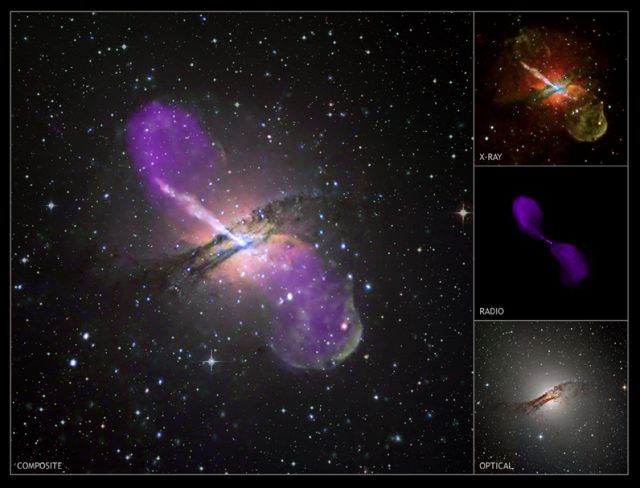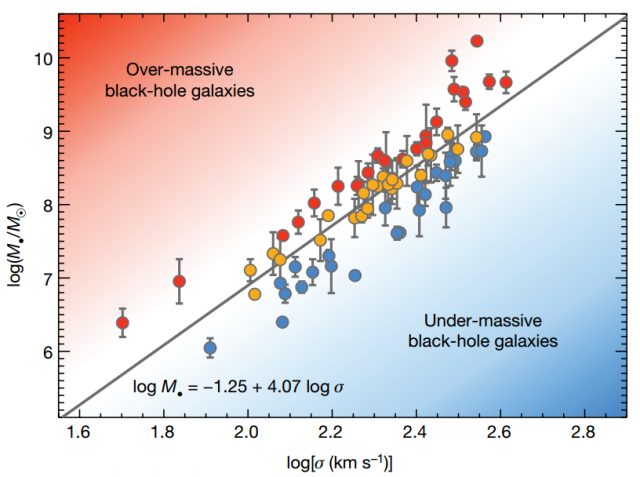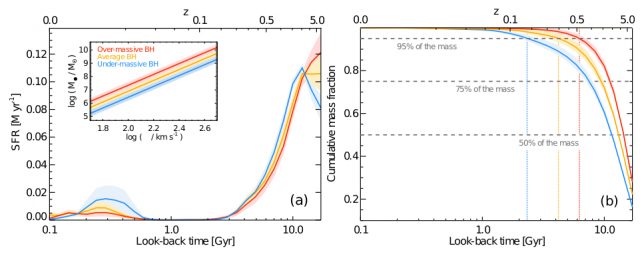How black holes affect star formation in massive galaxies
It is commonly said that Astronomy is an observational science. We cannot create and study stars or galaxies in our laboratories and, thus all the information we have from the Universe comes from observations. However, there is another approach: simulations. Astronomers use complex algorithms and computational techniques, in combination with the laws of physics, to recreate stars, solar systems, galaxies and large volumes of the Universe in our computers.
It is a fact, though, that when comparing large scale, cosmological simulations within the current Λ-Cold Dark Matter (ΛCDM) paradigm with the observable Universe, a number of discrepancies arises. Simulations tended to predict more satellite stellar systems around large galaxies than observed (missing satellite problem, 1), they failed at replicating disc-dominated galaxies with clear spiral structure as our Milky Way (angular momentum problem, 2), and they could not reproduce the number of galaxies with a given galactic mass (among other issues). Theoreticians needed mechanisms able to regulate star formation in galaxies in order to make simulations replicating observations. The proposed mechanism, that soon was proved successful, was the so-called “feedback”. On one hand, exploding massive stars (supernovae) could affect the star formation in low massive galaxies. On the other hand, accretion of material towards the central parts of massive galaxies, where supermassive black holes are found, can also emit great amount of light and radiation (active galactic nuclei, AGN), regulating the star formation in more massive systems. However, despite the efforts of many astronomers, observational evidences of such AGN feedback have remained elusive for long.

A study recently published in Nature have found the first observational evidences favoring the existence of such feedback 3. In this study the authors analysed high quality spectra (amount of energy emitted by the objects at different wavelengths) from the Hobby-Eberly Telescope Massive Galaxy Survey 4. In total, they analysed 74 galaxies (with black hole mass measurements) covering a good range of velocity dispersion (a proxy for the total mass of the galaxies) and black hole mass (see Fig. 2) values. Relying on the velocity dispersion vs. black hole mass relation, the sample of galaxies was divided into three categories (super-massive, standard, and under-massive black hole galaxies). The authors made use of modern algorithms to extract from the observed spectra information regarding the stellar composition of their targets 56. In particular, they were able to study the amount of stars that were formed in the three subcategories of galaxies at different stages of the galaxies evolution, since the very beginning of the Universe up to now (see Fig. 3).

It turned out that galaxies hosting black holes of different masses also display differences in the way they have formed stars. This can be easily interpreted as observational evidences claiming that, not only AGN feedback exists, but that the mass of the central supermassive black holes play an important role in how AGN feedback affects star formation in massive galaxies.

Galaxies that currently present over-massive black holes (red) show a higher star formation rate in the early stages of the Universe, when galaxies started to form. This early star formation induced the formation of a more massive black hole more than 10 billion years ago and the subsequent quenching (stop) of star formation in these galaxies. However, galaxies currently hosting under-massive black holes (blue) show a smoother early star formation ending up with black holes of lower mass and a more extended star formation that is not quenched so soon, forming 95% of their total stellar mass 4 billion years later than in the former case. Especially intriguing is the fact that the star formation histories of these two sets of galaxies do not only differ at early times. Black hole masses also have an effect in the recent star formation (last 700 million years), being under-massive black hole galaxies more efficient at forming stars than over-massive black hole systems.
And now, let me show you how all these new findings fit within our previous conception on how black hole mass and AGN activity could affect the star formation of galaxies. In order to form stars efficiently we need cold dust and gas; however, radiation emitted from the central parts of massive galaxies during their AGN phase heats the interstellar medium up, slowing down or even stopping the star formation. The larger the emission (or equivalently the more massive the black hole) the lower the star formation efficiency of the host galaxy would be. A direct consequence of this previously well-established scenario (not confirmed observationally until this work) is what the authors are finding in this paper: galaxies hosting more massive black holes should suppress star formation earlier than galaxies with low-mass black holes as well as recent star formation should be hampered in the former.
Although there is still too much to be known in the Universe around us, these results confirm long established hypothesis on the way galaxy formation and evolution work.
References
- Klypin, A.; Kravtsov, A.V.; Valenzuela, O.; Prada, F. “Where Are the Missing Galactic Satellites?” The Astrophysical Journal, Volume 522, Issue 1, pp. 82-92 (1999). DOI: 10.1086/307643. Link: http://adsabs.harvard.edu/abs/1999ApJ…522…82K ↩
- Steinmets, M.; Navarro, J.F. “The hierarchical origin of galaxy morphologies”, New Astronomy, Volume 7, Issue 4, p. 155-160. DOI: 10.1016/S1384-1076(02)00102-1 (2002). Link: http://adsabs.harvard.edu/abs/2002NewA….7..155S ↩
- Martín-Navarro, I.; Brodie, J.P.; Romanowsky, A.J.; Ruiz-Lara, T.; van de Ven, G. “Black-hole-regulated star formation in massive galaxies”, Nature, Volume 553, Issue 7688, pp. 307-309 (2018). DOI: 10.1038/nature24999. Link: http://adsabs.harvard.edu/abs/2018Natur.553..307M ↩
- van den Bosch, R.C.E.; Gebhardt, K.; Gültekin, K.; Yıldırım, A.; Walsh, J.L. “Hunting for Supermassive Black Holes in Nearby Galaxies With the Hobby-Eberly Telescope”, The Astrophysical Journal Supplement Series, Volume 218, Issue 1, article id. 10, pp. (2015). DOI: 10.1088/0067-0049/218/1/10 Link: http://adsabs.harvard.edu/abs/2015ApJS..218…10V ↩
- Ocvirk, P.; Pichon, C.; Lançon, A.; Thiébaut, E. “STECKMAP: STEllar Content and Kinematics from high resolution galactic spectra via Maximum A Posteriori”, Monthly Notices of the Royal Astronomical Society, Volume 365, Issue 1, pp. 74-84 (2006). DOI: 10.1111/j.1365-2966.2005.09323.x Link: http://adsabs.harvard.edu/abs/2006MNRAS.365…74O ↩
- Ruiz-Lara, T.; Pérez, I.; Gallart, C.; Alloin, D.; Monelli, M.; Koleva, M.; Pompei, E.; Beasley, M.; Sánchez-Blázquez, P.; Florido, E.; Aparicio, A.; Fleurence, E.; Hardy, E.; Hidalgo, S.; Raimann, D. “Recovering star formation histories: Integrated-light analyses vs. stellar colour-magnitude diagrams”, Astronomy & Astrophysics, Volume 583, id.A60, 23 pp (2015). DOI: 10.1051/0004-6361/201526752 Link: http://adsabs.harvard.edu/abs/2015A%26A…583A..60R ↩